Gayscape #5: Vampire Movie Edition
While the gay element in vampire literature has always been a bit more hidden, the homoerotic element in vampire films and television has always been that much more obvious, especially in the past 25 years or so-even going back to the dawn of vampire cinema, there’s been a pretty strong gay connection. Gaynnection?…nah.
Nosferatu (1922)
Nosferatu is the original vampire film, and nearly 90 years after it’s original release, it is still considered one of the greatest horror movies of all time. The vampire in Nosferatu, a thinly disguised version of Dracula named Count Orlock, is far removed from the romantic and suave (and sexualized) vamps of 19th century literature. Director F.W. Murnau opted for the traditional vampire of folklore, a terrifying and ugly revenant. And while Orlock was certainly interested in the blood of the film’s male protaganist, his approach was far more predator than seductor.
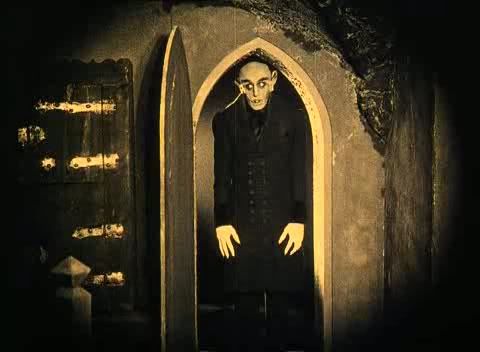
Nevertheless, Nosferatu has one glaringly gay element-its director F.W. Murnau. Murnau would die at age 43 in Hollywood, due to an accident that apparently involved a distracted director crashing his car while his Filipino houseboy was going down on him while driving.
Dracula’s Daughter (1936)
After the runaway success of Dracula in 1931, Universal waited a while for a followup. Originally set to be directed by James Whale, the openly gay director of Frankenstein and The Bride of Frankenstein, the movie ended up being no less queer when it eventually came out. Pun intended. Actress Gloria Holden played Countess Zoleska, the title character who comes to claim her father’s body. While in England, she decided to get psychiatric help to treat her affliction. I guess she thought some quack shrink could de-vamp her the way some people today think they can be “de-gayed”. In one of the film’s most famous scenes, Zaleska seduces and kills a young female prostitute in a pretty overtly sexual scene for a 30’s film. This was probably the earliest film to feature a reluctant vampire. Dracula’s Daughter was one of the only vampire movies to serve as inspiration to Anne Rice when creating her Vampire Chronicles, and she even named one of the prominent vampire bars in her books “Dracula’s Daughter”, after this film. Ironically, Dracula’s Daughter was located on the corner of Castro and 18th Street in San Francisco, where one prominent gay bar or another has stood for several decades.
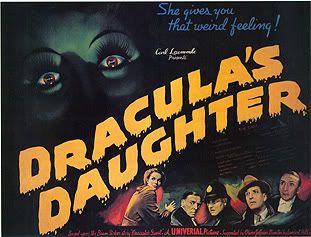
The Hammer Films
From 1958 through 1975, Hammer Studios produced some fifteen vampire themed films. While many of these focused on Dracula, several were loosely based on J. Sheridan La Fanu’s Carmilla. Lust for a Vampire, The Vampire Lovers, Twins of Evil and Countess Dracula. Most of these movies were light on plot and heavy on women with big breasts and big hair staring longingly at each other and then finally biting the shit out of each other in an orgy of blood stained white night gowns. Not to sound too straight about that, but…fucking awesome.
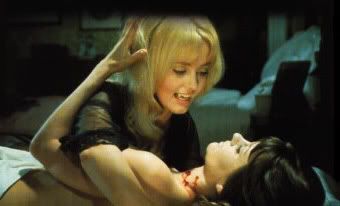
The Hunger (1983)
Based on Whitley Strieber’s novel, The Hunger is director Tony Scott’s first film and probably still his most non-commercial (this is the man whose next gig was Top Gun, after all). The Hunger’s opening sequence is one of the best ever; it features Catherine Deneuve and David Bowie as vamps on the prowl for victims at an early 80’s Goth Club to the tune of Bauhaus’ classic “Bela Lugosi’s Dead”. Denueve plays Miriam, a woman who has been undead since at least Egyptian times. She passed on her gift of vampirism to her lovers, who after a couple hundred years, begin to decay and need to be put away in coffins in the attic. After David Bowie quickly begins to turn into an old man, Miriam begins her seduction of a young female doctor played by Susan Sarandon. The entire seduction and transformation of Sarandon by Deneuve is tame by today’s soft core girl on girl action seen on Skinemax, but back in 1983 it was all pretty darn scandalous.
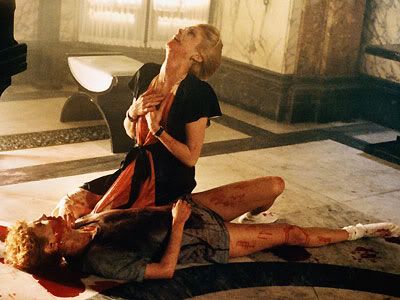
Fright Night (1885)
Tom Holland’s homage to the Hammer Horror films of his youth, Fright Night is the story is of an All-American teenager named Charlie Brewster, who has an attractive male vampire move in next door with his live-in interior designer. Can it get more gay than that?? Charlie does every dumb thing he can to draw the vamp next door’s attention, resulting in him vamping out Charlie’s best friend, horror geek “Evil” Ed. The scene where the Vampire (Chris Sarandon) decided to transform Evil Ed into a creature of the night in an alleyway is so beyond subtext that it is just plain old text. The actor who played Evil Ed (Stephen Geoffreys) went on to have a rather long career in gay porn. Go figure.
The Lost Boys (1987)
Directed by gay director Joel Schumacher, it’s no surprise that a little bit of queer sensibilty popped up in this movie (still less than his Batman flicks though). The main vamp, David (Kiefer Sutherland), seems intent on transforming the new kid in town, Jason Patric, into a vampire. Most of their scenes involve a lot of heavy posturing between the two of them, but when David gives Jason his blood, it’s conveniently in a bottle; thus avoiding any male to male physical contact. Still, the way those two glare at each other at all times makes you just wish they’d just get a room already.
Interview with the Vampire (1994)
Everything said about the novel can be said about the film translation as well. Many thought the homoerotic undertones would be removed due to the casting of Tom Cruise and Brad Pitt (remember, this is 1994, ten years before Brokeback Mountain); but just going by the book, the vampires in this universe do not have sex. For them the kill IS the equivalent of sex. So the best way for the movie to get around it was by not going around it at all. To the average movie goer, the main vampires were merely biting each other and sucking each other’s wrists, but anyome who understood “Metaphor:101” knew what was really going on here.
Buffy the Vampire Slayer (1997-2003)
Joss Whedon’s seminal television series is of great importance to GLBT portryals in the media. However, the character who was outed as gay wasn’t a vampire at all, it was Buffy’s best friend Willow, played by Allison Hannigan. The vamps on Buffy initially seemed more or less straight, despite mild flirting between female vamps Darla and Drusilla over on the Buffy spin-off Angel. Towards the end of Angel, however, fellow vampire Spike scoffs when someone refers to him as “an intimate member of Angel’s inner circle”, “Angel and I were never intimate” he says. “Well, except that one time” And with that sentence, a million fanfics were written all across the internet.
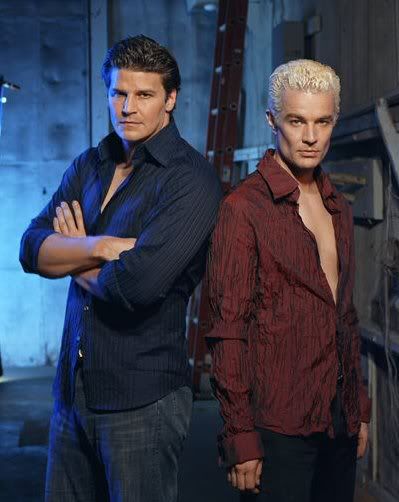
True Blood (2008)
The latest vampire sensation based on a series of popular novels. Nope, not that book series. Created by Alan Ball of Six Feet Under and American Beauty fame, this show has none of the melancholy musings on life, and prefers to keep to its “vampires as the new persecuted minority” metaphor. Yeah, not TOO obvious there, are we Alan Ball?
